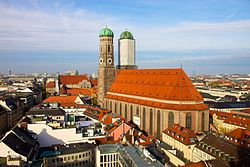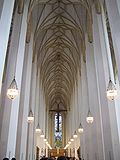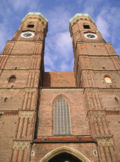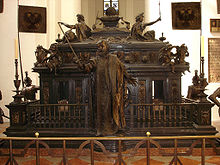- Munich Frauenkirche
-
Dom zu Unserer Lieben Frau (Frauenkirche) 
Frauenkirche viewed from nearby New Town Hall
Basic information Location Frauenplatz 1 Geographic coordinates 48° 8′ 19″ N, 11° 34′ 26″ E Affiliation Roman Catholic District Roman Catholic Archdiocese of Munich and Freising Ecclesiastical or organizational status Cathedral Architectural description Architect(s) Jörg von Halsbach Architectural style Gothic architecture and the domes constructed in Renaissance style Completed Consecrated in 1494, Domes added in 1524 Specifications Capacity 20,000 Length 109 meters (358 ft) Width 40 meters (131 ft) Spire(s) 2 Spire height 99 meters (325 ft) Materials Brick The Frauenkirche (full name Dom zu unserer lieben Frau, "Cathedral of Our Dear Lady") is a church in the Bavarian city of Munich that serves as the cathedral of the Archdiocese of Munich and Freising and seat of its Archbishop. It is a landmark and is considered a symbol of the Bavarian capital city.
The church towers are widely visible because of local height limits. The city administration prohibits buildings with a height exceeding 109 metres (358 ft) in the city center. Since November 2004, this prohibition has been provisionally extended outward and as a result, no buildings may be built in the city over the aforementioned height. The south tower is open to those wishing to climb the stairs and offers a unique view of Munich and the nearby Alps.[1]
Contents
History
The cathedral, which replaced an older romanesque church built in the 12th century, was commissioned by Duke Sigismund and erected by Jörg von Halsbach. For financial reasons and due to the lack of a nearby stone pit, brick was chosen as building material. Construction began in 1468.[2] Since the cash resources were exhausted in 1479 Pope Sixtus IV granted an indulgence. The two towers were completed in 1488 and the church was consecrated in 1494. However, the building's famous domes atop each tower were not added until 1525. Their design was modelled on the Dome of the Rock in Jerusalem, which in turn took a lead from late Byzantine architecture.[3] The cathedral suffered severe damage during World War II — the roof collapsed and one of the towers suffered severe damage. A major restoration effort began after the war and was carried out in several stages, the last of which coming to an end in 1994.[4]
Architecture
The Frauenkirche was constructed from red brick in the late Gothic style within only 20 years. The building is designed very plainly, without rich Gothic ornaments.
The Late Gothic brick building with chapels surrounding the apse is 109 metres (358 ft) long, 40 metres (130 ft) wide, and 37 metres (121 ft) high. Contrary to a widespread legend that says the two towers with their characteristic domes are exactly one meter different in height, they are almost equal: the north tower is 98.57 metres (323.4 ft) while the south tower is only 98.45 metres (323.0 ft), 12 centimetres (4.7 in) less. The original design called for pointed spires to top the towers, much like Cologne Cathedral, but those were never built because of lack of money. Instead, the two domes were constructed during the Renaissance and do not match the architectural style of the of the building, however they have become a distinctive landmark of Munich.
Interior
 Munich Frauenkirche Interior highlighting No window effect
Munich Frauenkirche Interior highlighting No window effect
The cathedral can hold approximately 20,000 people, and Catholic Mass is held regularly. The interior of the cathedral, which is among the largest hall churches in southern Germany, consists of the nave and two side aisles of equal height (31 metres (102 ft)). The arches were designed by Heinrich von Straubing.
Constructing a church with a capacity of 20,000 is surprising when one considers at end of the 15th Century the city only had about 13,000 inhabitants. The interior does not overwhelm despite its size because the double-row of 22 metres (72 ft) high columns helps enclose the space. From the main portal the view seems to be only the rows of columns with no windows and durchlichtete "walls" between the vaults through which the light seems to shine. The spatial effect of the church is connected with a legend about a footprint in a square tile at the entrance to the nave, the so-called "devil's footstep".
A rich collection of 14th to 18th century artwork of notable artists like Erasmus Grasser, Jan Polack, Hans Krumpper and Ignaz Günther decorates the interior of the cathedral again since the last restoration. The Gothic nave, several of the Gothic stained-glass windows, some of them made for the previous church, and the tomb monument of Louis IV, Holy Roman Emperor are major attractions.
Teufelsschritt, or Devil's Footstep
Much of the interior was destroyed during WWII. An attraction that survived is the Teufelsschritt, or Devil's Footstep, at the entrance. This is a black mark resembling a footprint, which according to legend was where the devil stood when he curiously regarded and ridiculed the windowless church that Halsbach had built.
In another version of the legend, the devil made a deal with the builder to finance construction of the church on the condition that it contain no windows. The clever builder, however, tricked the devil by positioning columns so that the windows were not visible from the spot where the devil stood in the foyer. When the devil discovered that he had been tricked, he could not enter the already consecrated church. The devil could only stand in the foyer and stomp his foot furiously, which left the dark footprint that remains visible in the church's entrance today.
Legend also says the devil then rushed outside and manifested its evil spirit in the wind that furiously rages around the church.[5]
Burial places
The crypt contains the tombs of the Archbishops of Munich and Freising and among others of these members of the Wittelsbach dynasty:
- Louis IV, Holy Roman Emperor
- Duke Louis V
- Duke Stephen II
- Duke John II
- Duke Ernest
- Duke William III
- Duke John IV
- Duke Albert IV
- Duke William IV
- Duke Albert V
- King Ludwig III
See also
References
- ^ "Rising from Rubble 1945-1960". Munich Official City Portal. 2010. http://www.muenchen.de/Rathaus/plan/stadtentwicklung/flaechennutzplan/stadt_bau_plan_index/160831/section5.html. Retrieved 21 December 2010.
- ^ "Cathedral to our lady". Munich-info. 2007. http://www.munich-info.de/portrait/p_frauenkirche_en.html. Retrieved 21 December 2010.
- ^ "Building History (in German)". Der Münchner Dom. 2006. http://www.muenchner-dom.de/index.php?id=77. Retrieved 21 December 2010.
- ^ "Munich churches:Frauenkirche". My Travel Munich. 2007. http://www.mytravelmunich.com/frauenkirche.html. Retrieved 21 December 2010.
- ^ "Frauenkirche". Desination Munich. 2010. http://www.destination-munich.com/frauenkirche.html. Retrieved 21 December 2010.
External links
- Photos
Coordinates: 48°08′19″N 11°34′26″E / 48.13861°N 11.57389°E
Categories:- 1490s architecture
- Gothic architecture in Munich
- Roman Catholic cathedrals in Germany
- Cathedrals in Germany
- Visitor attractions in Munich
- Churches in Munich
Wikimedia Foundation. 2010.



